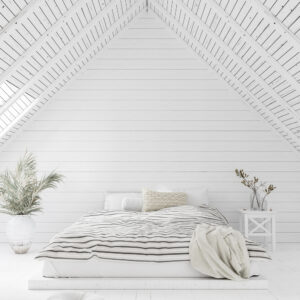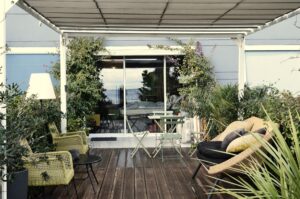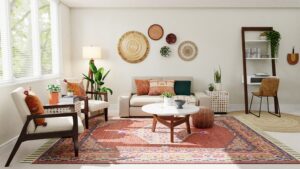Ultimate Guide to Eco-Friendly Construction Materials for Modern Sustainable Design
May 27, 2024
Oceanus Design
Introducing eco-friendly construction materials guide for modern sustainable design – Are you looking to create a harmonious blend of sophistication and environmental responsibility in your next design project? The selection of construction materials holds the key to shaping a modern sustainable space that not only exudes elegance but also minimizes its ecological footprint. In this comprehensive guide, we delve into the realm of eco-friendly materials, offering insights and recommendations to guide you towards a greener, more sustainable future in construction and design.
Benefits of Eco-Friendly Construction Materials for Sustainable Design
Improved Indoor Air Quality
Indoor air quality is crucial for the health and well-being of building occupants. Eco-friendly construction materials such as low-VOC paints, natural insulation materials like wool or hemp, and formaldehyde-free wood products contribute to a healthier indoor environment by reducing harmful emissions and off-gassing.
Energy Efficiency
Choosing energy-efficient materials can significantly reduce the carbon footprint of a building. Sustainable options like solar panels, cool roofs, and triple-paned windows help improve energy performance and decrease reliance on non-renewable energy sources.
Reduced Environmental Impact
Traditional construction materials often have a negative impact on the environment due to extraction processes, transportation emissions, and high levels of waste. By using eco-friendly materials like reclaimed wood, recycled steel, and sustainable concrete alternatives, builders can minimize environmental harm and promote a more circular economy.
Longevity and Durability
Investing in high-quality, sustainable materials may initially cost more, but the long-term benefits outweigh the upfront expenses. Materials like bamboo flooring, recycled metal roofing, and durable composite wood products are not only eco-friendly but also built to last, reducing the need for frequent replacements and repairs.
-
Opt for low-VOC paints and finishes to improve indoor air quality.
-
Choose energy-efficient windows and doors to enhance building performance.
-
Consider using reclaimed materials for a unique and sustainable design aesthetic.
For more information on sustainable building practices, check out LEED certification standards.
Types of Eco-Friendly Insulation Materials for Sustainable Building
Recycled Denim Insulation
Recycled denim insulation, also known as cotton insulation, is made from shredded denim scraps salvaged from clothing manufacturing processes. This eco-friendly material offers excellent insulation properties while diverting textile waste from landfills. It is safe to handle and free from harmful chemicals typically found in traditional insulation products.
Cellulose Insulation
Cellulose insulation is another popular eco-friendly option made from recycled paper fibers, primarily newspaper. This material is treated with non-toxic additives for fire resistance and pest control. Cellulose insulation is a cost-effective and energy-efficient choice for insulating walls, attics, and roofs in sustainable construction projects.
Wool Insulation
Wool insulation, derived from sheep's wool, is a natural and renewable material known for its breathability and moisture-regulating properties. Wool fibers provide effective thermal insulation, sound absorption, and fire resistance. Wool insulation is biodegradable, non-toxic, and requires less energy to produce compared to synthetic alternatives.
Cork Insulation
Cork insulation is made from the bark of cork oak trees and is a sustainable choice for eco-conscious builders. This material offers thermal and acoustic insulation properties, while also being resistant to mold, mildew, and pests. Cork insulation is a durable option that contributes to a healthier indoor environment and reduces overall energy consumption.
-
Recycled denim insulation is a sustainable alternative to traditional fiberglass insulation.
-
Cellulose insulation is an energy-efficient choice made from recycled paper fibers.
-
Wool insulation provides natural thermal properties and is biodegradable.
-
Cork insulation offers sustainable insulation with mold and pest resistance.
For more information on eco-friendly insulation materials, visit American Fiber Cement Corporation.
Sustainable Flooring Options for Modern Eco-Friendly Design
Bamboo Flooring
Bamboo flooring is a popular choice for eco-friendly construction due to its rapid renewability and sustainability. Bamboo grows much faster than traditional hardwood trees, making it a more environmentally friendly option. It offers durability, versatility in design, and is available in various finishes to complement modern sustainable interiors.
Cork Flooring
Cork flooring is made from the bark of cork oak trees, which naturally regenerate after harvesting, making it a renewable and sustainable material. Cork is resilient, comfortable underfoot, and provides excellent thermal and sound insulation properties. It is also hypoallergenic, resistant to mold and mildew, and a great choice for eco-conscious homeowners.
Reclaimed Wood Flooring
Reclaimed wood flooring offers a unique blend of history, character, and sustainability for modern sustainable design projects. This eco-friendly option repurposes wood from old buildings, fences, and other sources, reducing the demand for newly harvested timber. Reclaimed wood adds warmth and charm to spaces while reducing environmental impact.
Linoleum Flooring
Linoleum flooring is a natural and biodegradable flooring material made from linseed oil, wood flour, cork dust, and pine resin. It is durable, easy to maintain, and available in a wide range of colors and patterns to suit various design preferences. Linoleum flooring is an eco-friendly choice for sustainable construction projects seeking longevity and aesthetic appeal.
-
Bamboo flooring is a sustainable alternative to hardwood floors with a quick growth cycle.
-
Cork flooring provides comfort, insulation, and durability, sourced from renewable cork oak trees.
-
Reclaimed wood flooring adds character and history to spaces while reducing wood waste.
-
Linoleum flooring is a natural, biodegradable option suitable for eco-conscious homeowners.
For more information on sustainable flooring solutions, explore Armstrong Flooring's eco-friendly options.
Green Roofing Materials for Energy-Efficient Buildings
Solar Shingles
Solar shingles are innovative roofing materials that harness solar energy to generate electricity for buildings. These eco-friendly shingles blend seamlessly with traditional roofing materials, providing a sustainable energy solution without compromising the aesthetics of the building. Solar shingles offer long-term cost savings by reducing energy bills and promoting renewable energy usage.
Recycled Metal Roofing
Recycled metal roofing is a durable and eco-friendly option for sustainable building projects. Made from salvaged or recycled metal, such as aluminum or steel, these roofing materials are lightweight, resistant to fire and weather elements, and have a long lifespan. Recycled metal roofing reduces the need for new metal extraction and promotes circular economy practices.
Living Roof Systems
Living roof systems, also known as green roofs, are composed of vegetation, soil, and waterproofing layers installed on building rooftops. These systems provide numerous environmental benefits, including natural insulation, stormwater management, improved air quality, and habitat creation for wildlife. Living roof systems enhance the aesthetic appeal of buildings while promoting biodiversity and thermal regulation.
Cool Roofs
Cool roofs are designed to reflect sunlight and absorb less heat compared to traditional roofing materials. By reducing heat absorption, cool roofs help lower indoor temperatures, decrease energy consumption for cooling, and mitigate the urban heat island effect. Cool roofing materials come in various colors and coatings to suit different architectural styles and enhance energy efficiency.
-
Solar shingles combine sustainable roofing with renewable energy generation for eco-friendly buildings.
-
Recycled metal roofing offers durability, weather resistance, and supports recycling initiatives.
-
Living roof systems provide environmental benefits and biodiversity while improving building insulation.
-
Cool roofs reduce heat absorption, energy consumption, and contribute to urban heat island mitigation.
For more information on green roofing materials, visit Tesla Solar Roof.
Eco-Friendly Paints and Finishes for Sustainable Interior Design
Low-VOC Paints
Low-VOC (volatile organic compound) paints are considered eco-friendly alternatives to conventional paints due to their reduced emissions of harmful chemicals. These paints have lower levels of VOCs, which helps improve indoor air quality and reduce health risks for occupants. Low-VOC paints come in a variety of colors and finishes, making them ideal for sustainable interior design projects.
Milk Paint
Milk paint is a natural, biodegradable paint option made from milk protein, lime, and pigments. This environmentally friendly paint produces a unique, matte finish and is free from harmful additives or solvents. Milk paint is an excellent choice for achieving a rustic or vintage look in eco-conscious interior design while adhering to sustainable principles.
Clay-Based Finishes
Clay-based finishes, such as clay plaster and clay paint, are traditional and sustainable alternatives to modern paint products. These finishes are composed of natural clays, aggregates, and mineral pigments, providing a breathable and mold-resistant surface. Clay-based finishes offer a textured aesthetic, regulate indoor humidity levels, and contribute to a healthier living environment.
Natural Oils and Waxes
Natural oils and waxes are used as eco-friendly alternatives to synthetic varnishes and sealants for wood surfaces. Linseed oil, beeswax, and carnauba wax are common natural options that enhance the beauty of wood while providing protection against moisture and wear. These natural finishes are biodegradable, easy to apply, and suitable for sustainable interior design projects.
-
Opt for low-VOC paints to reduce indoor air pollution and enhance occupant health.
-
Utilize milk paint for a natural, vintage look without harmful additives.
-
Consider clay-based finishes for breathable, mold-resistant wall treatments.
-
Use natural oils and waxes to protect wooden surfaces in a sustainable manner.
For more information on eco-friendly paint options, explore Sherwin-Williams' Harmony Paint Collection.
Sustainable Building Materials for Structural Integrity
Hempcrete
Hempcrete is a bio-composite material made from hemp fibers, lime, and water, known for its sustainability and energy-efficient properties. This eco-friendly material offers excellent thermal insulation, moisture regulation, and carbon sequestration capabilities. Hempcrete is lightweight, breathable, and has a minimal environmental impact, making it a versatile choice for sustainable and durable construction.
Straw Bale Construction
Straw bale construction utilizes straw bales as building materials for walls, providing natural insulation and energy efficiency. Straw bales are renewable, locally-sourced, and have high thermal resistance, reducing heating and cooling costs in buildings. This construction method is eco-friendly, cost-effective, and well-suited for modern sustainable design projects seeking alternative and sustainable building materials.
Rammed Earth
Rammed earth construction involves compacting a mixture of earth, gravel, sand, and clay into sturdy walls or structures. This ancient building technique is environmentally friendly, utilizing natural and locally available materials. Rammed earth structures have excellent thermal mass, energy efficiency, and can contribute to healthier indoor environments by regulating temperature and humidity naturally.
Engineered Wood Products
Engineered wood products, such as cross-laminated timber (CLT) and laminated veneer lumber (LVL), are sustainable alternatives to traditional solid wood for structural elements. These materials are made by bonding or compressing layers of wood together to create strong and stable building components. Engineered wood products support sustainable forestry practices, reduce waste, and offer structural integrity for modern eco-friendly construction projects.
-
Hempcrete provides thermal insulation and carbon sequestration benefits for sustainable buildings.
-
Straw bale construction offers renewable and energy-efficient solutions for eco-conscious design.
-
Rammed earth structures utilize natural materials to promote energy efficiency and indoor comfort.
-
Engineered wood products like CLT and LVL support sustainable forestry and structural stability.
For more information on sustainable building materials, visit WoodWorks.
Energy-Efficient Windows and Doors for Eco-Friendly Homes
Triple Paned Windows
Triple-paned windows offer superior insulation and energy efficiency compared to traditional double-paned windows. These windows have three layers of glass with insulating gas between them, reducing heat transfer and enhancing thermal performance. Triple-paned windows help maintain consistent indoor temperatures, decrease energy consumption for heating and cooling, and contribute to a more sustainable and eco-friendly home design.
Fiberglass Doors
Fiberglass doors are durable, energy-efficient, and low-maintenance options for eco-conscious homeowners. These doors are resistant to warping, cracking, and rotting, making them long-lasting and sustainable. Fiberglass doors have high insulation values, reducing energy loss and enhancing the overall efficiency of a home. They come in various styles and finishes to complement modern sustainable designs.
Insulated Glass Doors
Insulated glass doors feature multiple panes of glass separated by insulating airspace, providing enhanced thermal performance and noise reduction. These doors are energy-efficient, contributing to lower heating and cooling costs while improving indoor comfort. Insulated glass doors promote natural light penetration, thermal insulation, and a seamless connection between indoor and outdoor spaces in eco-friendly homes.
Energy Star Rated Products
Energy Star is a certification program that designates energy-efficient products meeting specific criteria for performance and environmental impact. Energy Star rated windows and doors guarantee high energy efficiency, optimal insulation, and reduced greenhouse gas emissions. By choosing Energy Star rated products, homeowners can lower their energy bills, minimize carbon footprint, and create more sustainable living environments.
-
Triple-paned windows improve insulation and thermal performance in eco-friendly homes.
-
Fiberglass doors offer durability, energy efficiency, and low maintenance for sustainable design.
-
Insulated glass doors provide enhanced thermal performance and noise reduction benefits.
-
Energy Star rated products ensure energy efficiency, lower utility costs, and environmental sustainability.
For more information on energy-efficient windows and doors, explore Andersen Windows & Doors.
Water-Saving Fixtures and Plumbing Materials for Sustainable Living
Low-Flow Toilets
Low-flow toilets are eco-friendly fixtures designed to minimize water consumption during flushing. These toilets use significantly less water per flush compared to traditional models, reducing water waste and promoting sustainable water usage. Low-flow toilets help lower water bills, conserve freshwater resources, and support environmentally conscious practices in modern sustainable homes.
Water-Efficient Showerheads
Water-efficient showerheads are designed to reduce water usage without sacrificing water pressure or shower experience. These fixtures utilize technology to restrict water flow while maintaining an optimal showering experience. Water-efficient showerheads help conserve water, decrease energy costs associated with water heating, and contribute to sustainable living practices for eco-friendly homes.
Rainwater Harvesting Systems
Rainwater harvesting systems capture and store rainwater for various non-potable uses within a household. This sustainable practice reduces demand on municipal water supplies and promotes self-sufficiency in water management. Rainwater harvested can be used for watering plants, flushing toilets, and other household tasks, contributing to water conservation and sustainable living.
Eco-Friendly Irrigation Systems
Eco-friendly irrigation systems utilize efficient technologies to water landscapes and gardens while minimizing water waste. Drip irrigation, soil moisture sensors, and smart irrigation controllers are examples of eco-friendly irrigation solutions that optimize water distribution and reduce runoff. These systems help conserve water, promote healthy plant growth, and support sustainable landscaping practices.
-
Install low-flow toilets to reduce water consumption and promote sustainable water usage.
-
Use water-efficient showerheads to conserve water and reduce energy costs.
-
Implement rainwater harvesting systems to capture and utilize rainwater for various household purposes.
-
Opt for eco-friendly irrigation systems to efficiently water landscapes and gardens while minimizing water waste.
For more information on water-saving fixtures and systems, visit Kohler's Water-Saving Products.
Innovative Recycled Materials for Modern Sustainable Construction
Recycled Glass Countertops
Recycled glass countertops are eco-friendly surfaces made from post-consumer or post-industrial glass materials. These countertops offer a unique aesthetic appeal with varied color options and glass fragments visible within the surface. Recycled glass countertops are durable, heat-resistant, and easy to maintain, providing a sustainable and stylish choice for modern sustainable kitchens and bathrooms.
Reclaimed Brick and Stone
Reclaimed brick and stone are salvaged materials that offer character, history, and sustainability to construction projects. These materials are sourced from demolished buildings or structures, reducing the demand for newly quarried stone and clay bricks. Reclaimed brick and stone add a rustic charm to interiors and exteriors while promoting the reuse and preservation of valuable building materials.
Upcycled Metal for Structural Elements
Upcycled metal, such as recycled steel beams or aluminum trusses, can be repurposed for structural elements in sustainable construction. This practice reduces the need for new metal production, lowers energy consumption, and minimizes waste generation. Upcycled metal provides strength, durability, and a contemporary industrial aesthetic in modern sustainable building designs.
Recycled Plastic Building Blocks
Recycled plastic building blocks are innovative construction materials made from recycled plastic waste, such as bottles or containers. These blocks are lightweight, durable, and water-resistant, offering an environmentally friendly alternative to traditional concrete blocks. Recycled plastic building blocks contribute to waste reduction, promote circular economy principles, and provide versatile building solutions for eco-conscious projects.
-
Consider recycled glass countertops for a sustainable and visually appealing kitchen or bathroom upgrade.
-
Use reclaimed brick and stone to add character and history to interior and exterior design projects.
-
Explore upcycled metal options for strong structural elements with an industrial aesthetic.
-
Utilize recycled plastic building blocks for lightweight, durable, and eco-friendly construction solutions.
For more information on innovative recycled materials, visit TerraCycle's Recycled Plastic Products.
Conclusion: Embracing Eco-Friendly Construction Materials for a Greener Future
As we strive towards creating sustainable living spaces and buildings, the choice of construction materials plays a crucial role in reducing environmental impact and promoting a greener future. By embracing eco-friendly construction materials, we can enhance the quality, efficiency, and sustainability of modern design projects. From recycled glass countertops to reclaimed brick and stone, each material choice contributes to a more eco-conscious and responsible approach to construction.
Incorporating innovative recycled materials, such as upcycled metal and recycled plastic building blocks, not only diversifies design possibilities but also supports circular economy principles and waste reduction efforts. By prioritizing energy-efficient windows, low-flow toilets, and water-efficient fixtures, we can actively conserve resources and reduce utility costs while promoting eco-friendly living practices.
By utilizing sustainable flooring options, energy-efficient roofing materials, and water-saving irrigation systems, we can create modern, sustainable designs that prioritize environmental stewardship and long-term durability. With a commitment to eco-friendly construction materials, we can build healthier, more energy-efficient homes and spaces that align with the principles of modern sustainable design.
Let's continue to explore and implement eco-friendly construction materials in our projects, working towards a greener, more sustainable future for generations to come.
For further inspiration and information on sustainable living and design, visit IKEA's Sustainable Living.
Are eco-friendly construction materials more expensive than traditional materials?
Choosing eco-friendly construction materials does not necessarily mean a higher cost. While some sustainable materials may have a premium price tag, the long-term benefits of reduced energy consumption, lower maintenance costs, and environmental preservation often outweigh the initial investment. Additionally, the growing demand for eco-friendly materials has led to more competitive pricing in the market.
How can eco-friendly construction materials contribute to energy efficiency in buildings?
Eco-friendly construction materials, such as insulated windows, energy-efficient appliances, and sustainable insulation, play a significant role in enhancing energy efficiency in buildings. These materials help maintain optimal indoor temperatures, reduce the need for heating and cooling, and lower energy consumption. By choosing energy-efficient materials, buildings can operate more sustainably and reduce their overall carbon footprint.
Are there regulations or certifications for eco-friendly construction materials?
Several certifications and standards exist to identify and verify eco-friendly construction materials. Organizations like LEED (Leadership in Energy and Environmental Design) and Energy Star provide certifications for sustainable building materials based on specific criteria such as energy efficiency, environmental impact, and resource conservation. Checking for these certifications can help ensure the eco-friendliness of construction materials.
How can recycled materials be incorporated into modern sustainable design projects?
Recycled materials can be seamlessly integrated into modern sustainable design projects in various ways. From utilizing recycled glass countertops and reclaimed wood flooring to incorporating upcycled metal elements and recycled plastic building blocks, designers can add unique touches, reduce waste, and promote circular economy practices in their projects. Recycled materials not only showcase creativity but also contribute to a more sustainable design approach.
What are the environmental benefits of using eco-friendly construction materials?
Utilizing eco-friendly construction materials offers a wide range of environmental benefits, including reduced carbon emissions, conservation of natural resources, decreased waste generation, and improved indoor air quality. By choosing sustainable materials like bamboo flooring, low-VOC paints, and rainwater harvesting systems, designers and builders can create spaces that positively impact the environment, promote eco-conscious living, and contribute to a greener future.









